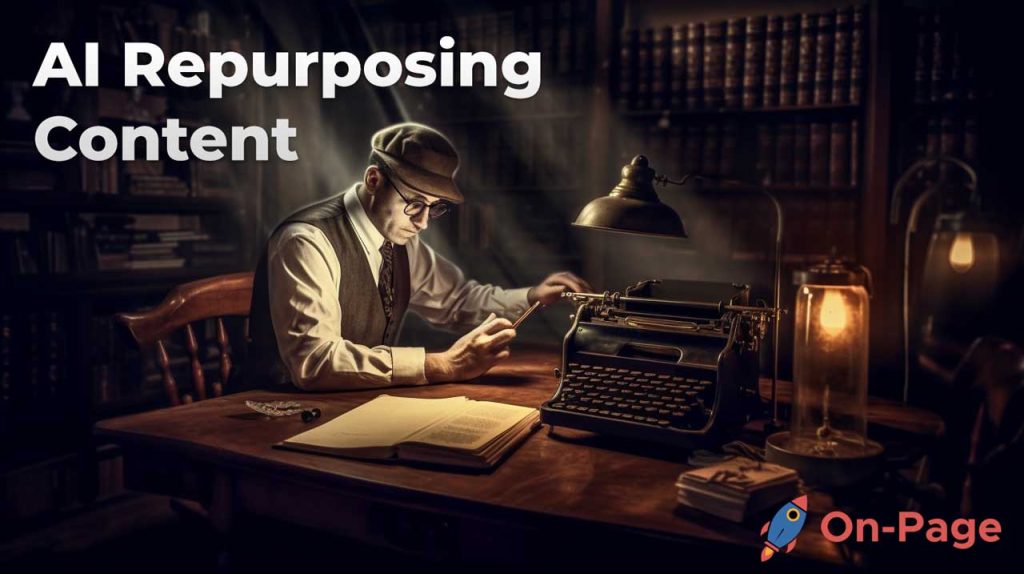Imagine a world where penning captivating articles, crafting persuasive sales copies, and composing eloquent emails become as effortless as pushing a button. At the speed of a thought, you can churn out well-structured and engaging content – all without breaking a sweat by using On-Page.ai. Sounds too good to be true? Well, not anymore! Get ready to explore the fascinating realm of Artificial Intelligence in business writing, as we unveil how the power of AI is revolutionizing the way we write and communicate in the digital age. Say goodbye to tedious composition tasks and writer’s block, because it’s time to embrace a game-changing paradigm shift that will transform your literary experience forever!

Artificial intelligence is transforming many aspects of business writing, including speeding up the process, improving quality, and reducing costs for editing and proofreading. AI-powered tools can find relevant information, eliminate duplication, and make editing easier. Additionally, AI can help with routine automation, mistake elimination, and strategy development. By using these tools, companies can save time and money while ensuring the quality of their work is not compromised.
Automated Business Writing with AI
Artificial intelligence has revolutionized various industries, and business writing is no exception. Writing compelling and effective documents for businesses can be a challenging task, but with the help of AI technology, it’s now faster and easier than ever before. AI-powered writing tools are assisting businesses to streamline their writing processes and produce high-quality content that aligns with their objectives.
AI-powered software such as On-Page.ai offers unique features tailored to streamline business writing projects. On-Page’s Stealth Writer is a full article creator where you input a keyword and with 1 click, it will write an article for you that is helpful and passes our AI detection. This allows users to produce relevant and engaging content in less time, freeing them up to focus on other important tasks.
The benefits of using AI-powered software for business writing are numerous. One such benefit is faster turnaround times for writing projects. With AI’s ability to process large volumes of data quickly, businesses can complete writing projects faster without sacrificing quality.
AI can also improve the accuracy and consistency of written content by identifying language errors, typos, or inconsistencies in tone or style across multiple documents.
Additionally, AI helps ensure compliance with industry-specific regulations or legal requirements through comprehensive checks for keywords or phrases that may violate established standards.
Despite the many benefits of using AI technology for business writing, some people might worry about losing the personal touch that comes with human interaction. Some people argue that automated writing could lead to a standardized approach that makes corporate communications even more impersonal than they already are.
However, just as word processing software changed how people wrote letters several decades ago, so too will AI-powered software change how people approach business communication. Automated writing tools are not supposed to replace writers; instead, they are meant to assist them in producing high-quality content quickly and efficiently.
With that said, it is time to look at the ways in which AI technology can enhance efficiency in writing processes.
Enhancing Efficiency in Writing Processes

One of the most significant benefits of using AI-powered software for business writing is the enhanced efficiency it brings. For businesses facing tight deadlines or a high volume of writing needs, manually producing well-written documents can be cumbersome and challenging. This is where AI comes into play.
With its ability to process large volumes of data quickly, AI-powered tools offer incredible speed and accuracy when it comes to handling complex writing tasks. This enables companies to produce high-quality written content rapidly, saving them both time and money while allowing them to focus on other critical aspects of their business operations.
AI also helps identify trends in data by analyzing keywords used across multiple documents, thus generating insights into how customers engage with the company’s communications. This data-driven approach allows businesses to optimize written content for engagement and better capture their audience’s attention.
A company that specializes in creating product descriptions could use an AI writing tool like On-Page.ai to create multiple versions of a product description tailored for different audience types automatically. In this way, the company can appeal to a broader range of customers without compromising quality or increasing their workload.
While some might worry that automated writing could reduce creativity, leading to generic or unengaging content, sophisticated AI language models are now available that can mimic human-like written forms. These models generate personalized messages by analyzing previous patterns of customer engagement with the brand and deliver unique experiences consistently.
Therefore, using artificial intelligence for writing permits brands to tap into an entirely new level of personalization and customization afforded by machine learning algorithms. This can result in highly targeted messages, resulting in higher conversion rates and overall better relationships between the brand and its audience.
Improved Document Quality and Data-Driven Insights

AI-assisted writing tools have revolutionized the way businesses handle their written documents. These software applications help to ensure that business documents contain necessary information, present a coherent message, and convey all required data accurately. By utilizing AI-powered document analysis features, businesses can effectively improve the quality of their written output while gaining vital insights into critical metrics of document performance.
One example of how AI writing tools such as On-Page.ai Content Editor tool enhance document quality is through their ability to analyze vocabulary. These tools can detect overused terms or redundant phrases in a document and suggest alternative phrases to promote clarity and conciseness. They also scan through the content of a document, highlighting sentences with poor grammar usage, spelling errors, and other inaccuracies.
Moreover, these AI solutions offer suggestions for improving sentence structure by encouraging concise sentences augmented by appropriate punctuation marks. As a result, AI-assisted writing tools help to improve readability while streamlining overall content delivery.
To illustrate this point further think about AI-assisted writing much like having an experienced editor at your beck and call 24/7. Imagine how an editor would review your work and suggest crucial changes to enhance its readability by removing errors and inconsistencies.
However, improved document quality is not the only benefit associated with using AI-powered writing solutions. Let us consider an additional advantage: harnessing data-driven insights for better results.
By providing access to real-time data analytics about content engagement metrics (such as click-through rates), AI-powered writing tools identify popular types of content, suitable topics, audience interests and preferences —information that businesses could use to create more effective marketing campaigns.
Analytical algorithms allow users to understand key patterns and trends within user behavior data. This data can assist businesses in evaluating which types of content drive greater engagement rates, creating targeted content to suit the unique interests and preferences of each demographic group.
While it is easy for many businesses to feel overwhelmed by managing vast amounts of customer data garnered from their websites or social media platforms, machine learning technologies like AI assist in organizing this data and providing insights into content performance trends. Some may argue that there is no need for additional technology since Google Analytics provides much of the same data. However, AI-powered writing solutions offer more flexibility and contextual relevance as compared to general data provided by Google Analytics.
Thus, although there are challenges associated with integrating AI-assisted writing tools into business workflows, the benefits they bring to the table are numerous. Let us now take a deeper dive into these challenges.
- According to a study by Gartner, by 2025, AI applications are predicted to generate $2.9 trillion in business value and recover 6.2 billion hours of worker productivity.
- A survey conducted by McKinsey found that approximately 60% of businesses have started to adopt AI technologies for at least one function in their organization, with improvements in areas like natural language processing playing a key role in better business writing.
- Research conducted by Deloitte shows that integrating AI capabilities into an organization’s processes can lead to a 20% reduction in time spent on specific tasks, including the drafting of documents and other written materials.
Overcoming Challenges of AI in Business Writing
As with any new technology system, AI-powered writing solutions come with their own set of challenges that organizations must be aware of before implementing them into their workflows.

One significant challenge that enterprises face when embracing artificial intelligence writing tools like On-Page Stealth AI Writer is employee reskilling. Employees so used to writing standard reports and documents manually might resist change or lack the skills necessary to use this new technology adequately.
However, businesses can overcome this resistance through adequate training and continued communication about how the tool could improve the quality and efficacy of the writing process. Companies should consider onboarding employees gradually and allocating resources for specialized training on using such tools effectively. Visit On-Page.ai Live Training to see what it has to offer in the field of business writing.
Another challenge associated with AI-powered writing software is ethical considerations concerning privacy and data security. Although most software vendors offer robust data protection measures and secure systems, some companies may feel uncomfortable having sensitive company information processed by third-party services. Additionally, there is growing public concern about issues such as biases resulting from AI-generated language and its potential misuse in impersonation scams.
To help resolve such concerns, companies can examine the security policies of their software providers closely, ensuring that they align with their internal security protocols. Just as one would assess a bank’s security measures before depositing large sums of money, organizations need to evaluate the security aspect of an AI tool before implementing it.
Despite these challenges, however, AI-assisted writing tools offer significant benefits for businesses looking to enhance both document quality and productivity. While it is easy for many organizations to resist changes, such technologies’ adoption ultimately results in improved resource utilization, reduced workload and enhanced profitability.
Potential Resistance and Ethical Concerns
As with any new technology, there is always the potential for resistance and ethical concerns. In the case of AI in business writing, these concerns range from job displacement to the ethical use of data. Let’s examine them in more detail.
- One potential concern is the impact of AI on human employment. With automation and AI becoming increasingly prevalent in various industries, there is a growing concern that many jobs will become obsolete. While it’s true that some jobs may be automated, such as simple data entry or formatting tasks, it’s important to note that AI cannot replace the creative thinking, empathy and critical reasoning that humans possess. It is reasonable to assume that once certain tasks are automated, others will arise that require human skills and expertise.
- Another ethical concern is the proper use of data. With AI-powered tools collecting vast amounts of data (such as writing patterns), there is a risk that this data could be misused or mishandled. Companies must take steps to ensure they are using data ethically and transparently, and adhere to the necessary data protection regulations.
- Additionally, there may be resistance among employees towards using AI-powered writing tools. They may feel uncomfortable with their work being analyzed by an algorithm or worry about losing their jobs to automation. However, it’s important for companies to shift the focus away from “replacing” humans with machines and instead emphasize the collaboration between the two. By working together, humans can provide context and creativity while AI can offer speed and accuracy.
AI Writing Tools and Applications
Despite these potential issues, AI-powered writing tools like On-Page.ai offer numerous benefits for businesses looking to improve their content creation process.
- One key benefit is improved efficiency: businesses can produce high-quality documents at a much faster pace than before. This is especially useful for large organizations that require heavy documentation, such as legal or finance departments.
- Another benefit is the ability to gain data-driven insights from writing patterns. With AI-powered tools, businesses can analyze their writing patterns and identify areas for improvement, such as repetitive phrasing or overused adjectives. This leads to more effective communication and a clearer message to their intended audience.
- Some may argue that AI-powered tools take away from the human element of writing, which should be about creativity and expression. However, it’s important to remember that these tools are merely aids and not meant to replace human intelligence. Instead, they allow writers to focus on the creative process without getting bogged down by tedious tasks like proofreading or formatting.
- Finally, AI-powered writing tools can help ensure consistency across an organization’s content. By using predefined templates and guidelines, businesses can ensure their written content adheres to brand voice and messaging. This can be particularly useful for businesses with multiple departments or branches operating in different regions, as it helps maintain a cohesive message.
Key Software and Advanced Features
One of the biggest advantages of AI-powered writing tools is their ability to offer advanced features that can help businesses achieve more with their content creation. Here are some of the key software and features you should be aware of:
1. WordHero: WordHero uses AI to create templates for documents by analyzing past projects and using machine learning to refine its approach. By doing so, it can suggest wording that is more in line with what your audience needs and wants.
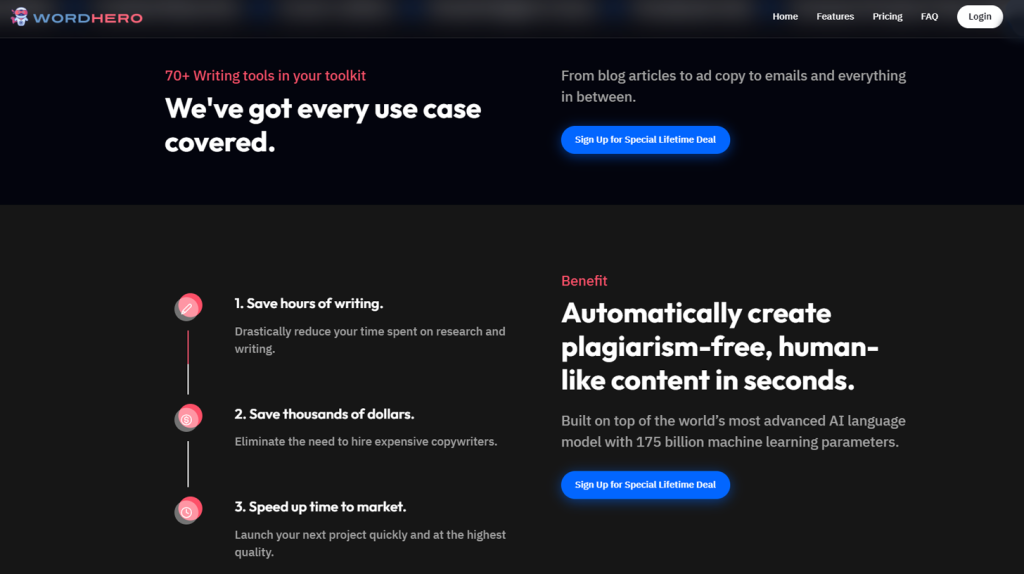
For example, imagine you’re tasked with writing a long report on your company’s latest earnings report. With WordHero, you can start by selecting a template that provides an outline of the types of information you need to include. Then, you can simply enter in your own data and customize the suggestions until they match your own voice and tone.
This is a great way to save time and effort when working on complex documents, as WordHero takes care of much of the tedious manual labor that can make report writing feel overwhelming.
2. Grammarly: Grammarly is one of the most well-known AI-powered writing tools out there, offering features like grammar checking, spell checking, and even suggestions for more clear or more concise phrasing.
For instance, if you write a sentence like “I’m not sure if I’m ready yet,” Grammarly might suggest an alternative like “I’m uncertain whether I’m prepared.” This kind of feedback can be invaluable for businesses looking to produce high-quality content that resonates with their target audiences.
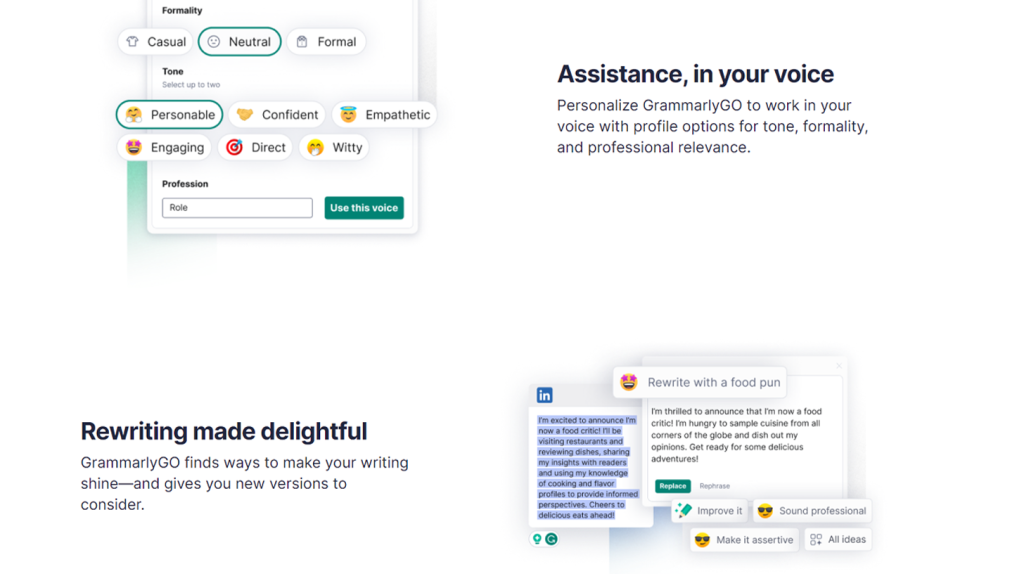
Additionally, Grammarly’s ability to catch spelling mistakes, punctuation errors, and other common writing issues ensures documents remain polished and professional-looking.
3. AnswerThePublic: One of the key challenges in business writing is figuring out what topics or themes will resonate with your target audience. This is where AnswerThePublic comes in handy, as it uses AI to analyze search engine queries and generate insights on popular topics and keywords.
Imagine you run a small business selling handmade candles online. By using AnswerThePublic, you can input your business name or relevant industry keywords, and the tool will provide an array of questions and suggestions related to candle products and their potential audiences.
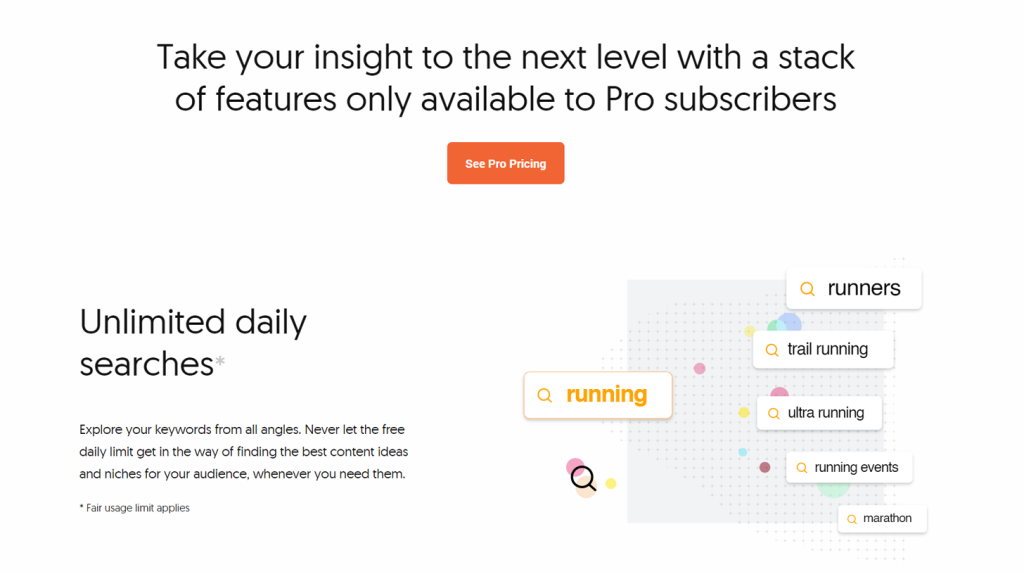
In essence, AnswerThePublic is like having an AI-powered marketing research team at your fingertips, providing valuable insights on what types of content may engage with consumers.
By leveraging these advanced software tools and features, businesses can streamline and optimize their writing processes while also ensuring the end result is high-quality and targeted to their audiences.
Alternatives and Complementary Solutions
Of course, while AI-powered writing tools offer a wide range of benefits, they’re not necessarily the best fit for every situation. In some cases, a more traditional approach to writing may be preferable. Here are a few alternatives and complementary solutions worth considering:
1. Manual-Only Writing: For those who prefer a more hands-on approach to writing processes, there’s always the option to stick with manual methods like pen-and-paper note taking or typed-out long form letters.

While this may seem counterintuitive given the many advantages of AI-powered tools, there are some scenarios where manual methods might actually be preferable. For instance, if you’re working on creative writing projects that require deep emotional connections or nuance in language use, relying solely on machines might detract from your work’s final product.
2. Outsourcing Writing Services: Another alternative to the AI-powered revolution in business writing is outsourcing content creation services to professional writers or writing agencies.

While this alternative might come off as expensive compared to just deriving powerful solutions from software tools like On-Page.ai or WordHero, it may be perfect to unleash the raw experiences of an expert community – people who have a deep understanding of how businesses can communicate with clients in various fields.
3. Hybrid Methods: Finally, businesses can consider using a hybrid approach that leverages both software tools and human expertise. This could involve using AI-powered writing tools for certain tasks like spell checking or content analysis, while leaving more complex or delicate work up to dedicated writers and editors.

For instance, imagine you’re part of a marketing team tasked with creating product descriptions for your company. You might start by inputting some basic keywords into AnswerThePublic to gain insight on popular topics. From there, you could use On-Page.ai to analyze existing webpages and improve your chances of ranking highly on search engine results pages.
By considering these alternatives and complementary solutions alongside AI-powered writing tools, businesses can ensure they’re optimizing their writing processes while achieving high-quality, audience-targeted results.
Traditional Writing Approaches and Hybrid Methods
While AI writing tools continue to gain popularity in the business world, traditional writing approaches and hybrid methods still play a significant role in the industry. There are still many businesses that rely on manual writing for their content creation and marketing processes. In fact, some companies choose to use a combination of both traditional writing and AI tools to achieve their goals.
For example, businesses that require highly specialized knowledge or specific sector expertise may prefer to use human writers. These industries include legal, medical, or financial services where precision and compliance with regulatory requirements is essential. Similarly, creative industries like advertising and marketing may also rely on human writers to produce original content that appeals to specific target audiences.
While there are benefits to using traditional writing approaches, it is important to acknowledge some of the challenges these methods can present. Manual writing can be time-consuming and labor-intensive, requiring extensive research, planning, drafting, and revisions. The process can lead to delays in production and added costs due to the need for additional resources such as editors or proofreaders.
Moreover, relying solely on manual writing can limit the scope of content production. Human writers may struggle to handle large-scale projects or maintain consistency across different pieces of content. Additionally, they may not have access to the same data-driven insights as AI tools when optimizing content for SEO purposes.
Consider a construction worker building a house entirely by hand versus a contractor using power tools and heavy machinery. Both approaches have their advantages and disadvantages depending on the scale of the project, budget constraints, and timeline requirements. While manual construction methods may lend themselves well to smaller-scale projects with more specific design needs for certain clients; larger-scale projects are more financially feasible through mechanized construction practices as machines deliver considerable savings in terms of production efficiency.
At the same time, it is worth noting that hybrid methods, which leverage both traditional writing and AI tools, can provide a balance between efficiency and quality of content. For example, businesses may use AI tools like On-Page Stealth Writer to automate repetitive and low-value tasks like grammar or spelling checks. This frees up human writers to focus on more creative aspects of content production, such as engaging storytelling or targeted messaging.
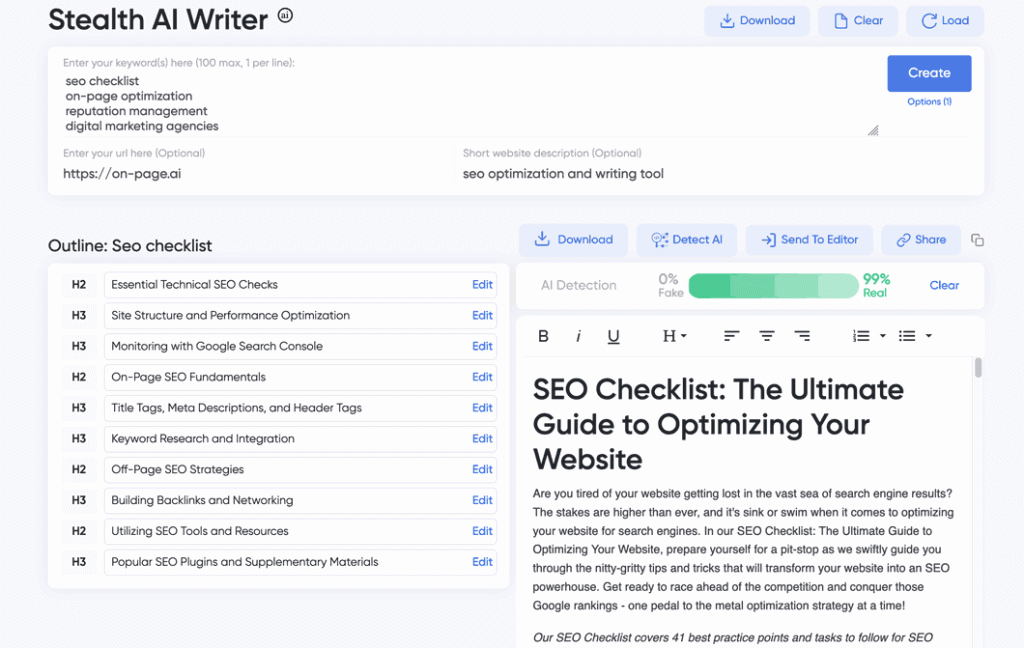
Ultimately, the choice between traditional writing approaches and AI tools depends on a variety of factors such as industry-specific needs, budget constraints, scalability requirements, and timelines. However, it is noteworthy that On-Page.ai offers a comprehensive suite of tools that cater to both traditional and modern writing approaches. It is always recommended to incorporate On-Page.ai Content Editor within any approach you choose, as the tool provides automated data-driven insights for SEO optimization whilst freeing human writers from mundane tasks.
Responses to Frequently Asked Questions with Explanations
How is AI changing the way businesses approach written communication?
AI is revolutionizing the way businesses approach written communication. From automated content creation to personalized messaging, AI tools are assisting companies with tasks that were once time-consuming and labor-intensive.
One of the most significant impacts of AI on business writing is automation. According to a report by MarketsandMarkets, the global AI in content creation market size is expected to reach USD 1.3 billion by 2026, growing at a CAGR of 30.4% from 2021 to 2026. AI-powered tools like GPT-3 can generate complex reports, presentations, and even articles with just a few clicks. This technology allows companies to publish more content quickly than ever before.
Personalization is another area where AI is making waves in business communication. Platforms like Grammarly use AI algorithms to analyze user behavior and make suggestions for improved grammar, tone, and language that will resonate better with individual users. By tailoring communication to each person’s preferences, businesses can build stronger relationships with their customers and employees alike.
Finally, chatbots are changing the way businesses communicate with their customers online. These AI-powered virtual assistants provide immediate assistance and support around the clock without requiring human intervention, reducing response times and increasing overall customer satisfaction.
Overall, it’s clear that AI is changing the game when it comes to business writing. From automation to personalization to increased efficiency, these technologies have a lot to offer modern businesses seeking an edge in today’s competitive marketplace.
What are the benefits of using AI in business writing?
There are numerous benefits of using Artificial Intelligence (AI) in business writing. First and foremost, the use of AI can significantly improve the efficiency and speed of writing tasks. According to a study by Gartner, by 2023, AI-powered tools will help reduce administrative tasks and streamline document creation by 30%.
Moreover, AI-powered algorithms can help identify and correct grammar and spelling mistakes more accurately than humans can. This can lead to more polished and error-free communication, enhancing the credibility of written work.
Another significant benefit is the ability of AI to generate data-driven insights through text analysis. By analyzing large volumes of written communication from various sources such as customer feedback, social media, or market reports, AI algorithms can draw valuable conclusions about customers’ needs, trends, and competitors’ performance.
Finally, the use of AI in business writing enables writers to personalize their communications at scale. With Natural Language Processing (NLP), artificial intelligence can analyze data points from individual customers to craft tailored messages that resonate with them. This kind of personalization leads to higher customer engagement rates and revenue growth.
In conclusion, the benefits of incorporating AI in business writing are undeniable. From time savings achieved through efficient paperwork to generating high-quality output via intelligent text analytics; AI offers businesses truly unique advantages they cannot afford not to utilize in these times.
What are the limitations of using AI in business writing?
AI has undoubtedly revolutionized the way we write in business settings, but it’s not without limitations. Perhaps the most significant limitation is that AI lacks the creativity and empathy of human writers. It cannot fully comprehend nuances in language or cultural references, meaning it may produce generic or inappropriate content. A study by Harvard Business Review revealed that 80% of consumers preferred to interact with a human customer support representative rather than a chatbot or virtual assistant.
Additionally, AI can struggle with generating original ideas and narratives that engage readers. The technology is programmed to follow algorithms and data sets, which limits its ability to think outside the box or generate thought-provoking content. Several companies have experimented with using AI for content creation, but many strategies proved unsuccessful because consumers often found AI-produced content dull and uninspiring.
Another limitation of AI in business writing is its inability to capture a company’s voice or personality accurately. Companies need their unique brand identities to resonate among consumers. Still, AI-generated content lacks the personal touch and authenticity of the brand, diluting its effectiveness in connecting with target audiences.
In conclusion, while AI presents numerous benefits when used for business writing, several limitations must not be ignored. It cannot replicate human creativity, cultural understanding, or empathy. Therefore companies should keep in mind these limitations before relying solely on AI-generated content for their marketing purposes.
Can AI really improve the quality and effectiveness of business writing?
Yes, AI can definitely improve the quality and effectiveness of business writing by providing valuable insights and automating tedious tasks. With the help of machine learning algorithms and natural language processing techniques, AI can analyze data, generate reports, suggest improvements, and even write content in some cases.
According to a study by Narrative Science, 80% of business executives believe that AI can improve the decision-making process by analyzing data and generating insights. Similarly, Gartner predicts that by 2022, half of all analytical queries will be generated via search, natural language processing or voice commands.
AI-assisted writing tools like Grammarly and Ginger Software have already gained widespread popularity among professionals for their ability to detect grammar errors, contextual spelling mistakes, and suggest stylistic improvements. In fact, Grammarly claims that its users make 400% fewer mistakes with their writing when using their service.
AI-powered content creation platforms like Copy.ai and Writesonic enable users to generate product descriptions, ad copy, blog posts, emails, and other types of content in minutes using natural language generation techniques. These tools are particularly useful for businesses that need large amounts of content quickly and on a regular basis.
In conclusion, AI has great potential in improving the quality and effectiveness of business writing by enabling more data-driven decision making, efficient automation of tedious tasks, improving language syntax and enhancing overall creativity while saving time.
How can businesses best integrate AI into their writing processes?
Businesses can best integrate AI into their writing processes by leveraging its capabilities to analyze data, generate insights, and automate repetitive tasks. Natural Language Processing (NLP) technology can help organizations optimize their writing style and improve the overall quality of their written content, from reports to emails.
- One way businesses can use AI in their writing is through sentiment analysis. According to a study by MarketsandMarkets, the global sentiment analysis market is projected to grow from $2.8 billion in 2019 to $6.4 billion by 2024. By using machine learning algorithms and NLP, businesses can quickly analyze customer feedback and sentiment in real-time, helping them make informed decisions about how to improve communication with customers or adapt marketing strategies.
- Another way businesses can benefit from AI is by using it for content creation. With advances in natural language generation (NLG), businesses can automate the production of routine reports, press releases, and other written content. This can save time on repetitive tasks and free up writers to focus on more creative endeavors.
- Finally, AI-powered editing tools are also valuable resources for businesses that want to enhance their writing processes. These tools leverage NLP algorithms to detect errors and offer suggestions for improving grammar, syntax, and style.
In conclusion, integrating AI into writing processes may seem daunting at first but has proven to be a worthwhile investment. By leveraging its capabilities effectively, businesses can streamline their workflows, increase productivity and tailor messaging to resonate with their audience more accurately. Register with On-Page.ai and look into solutions to aid you with your business writing.


